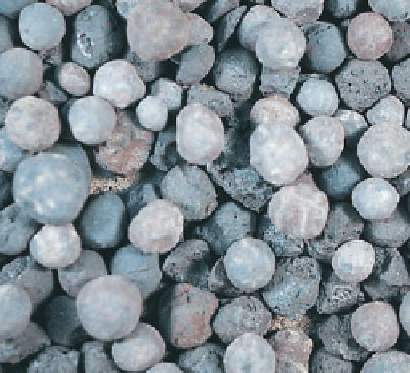Geology Reference
In-Depth Information
Geo-Focus
Banded Iron Formation—From Mine to Steel Mill
The United States and Canada, both
highly industrialized nations, owe a
good deal of their economic success to
abundant natural resources, although
both nations, especially the United
States, must import some essential
commodities. But iron ore is present
in great abundance in the Great Lakes
region and in the Labrador Trough of
eastern Canada. The giant iron-ore
freighters that ply the Great Lakes
sail from loading facilities in Ontario,
Minnesota, and Michigan to iron-
producing cities such as Hamilton,
Ontario, Cleveland, Ohio, and Gary,
Indiana.
Iron ore is produced from rocks
of various ages, but by far most of it
comes from Proterozoic
banded iron
formation
(BIF) consisting of alternat-
ing layers of iron-bearing minerals
(mostly hematite and magnetite) and
chert. We discussed what is known
about the origin of BIF, and remember
that 92% of it was deposited during
the Proterozoic Eon when Earth's
atmosphere lacked free oxygen—that
is, oxygen not combined with other
elements. Most BIF is not particularly
attractive, but some consists of alter-
nating layers of brilliant, silvery, iron
minerals and red chert, as at Jasper
Knob in Ishpeming, Michigan
(Figure 19.16a).
The richest iron ores in the Great
Lakes region had been largely
depleted by the time of World War II
(1939-1945), but then a technologic
innovation was developed that allowed
mining of poorer-grade ores. In this
process, the unusable rock is separated
from the iron, which is then shaped
into pellets before it is shipped to steel
mills (
◗
Figure 1
The Empire Mine at Palmer, Michigan, where iron ore from the
Paleoproterozoic-aged Negaunee Iron Formation is mined.
stored for later shipment or
taken directly to iron-ore
freighters at Duluth, Min-
nesota, Marquette, Michigan,
or other ports. And then
the iron-ore freighters make
their way through the Great
Lakes and deliver the pellets
to the steel mills.
The availability of iron ore
and a steel-making capacity
is essential for large-scale
industrialization. Accord-
ingly, industrialized nations
and developing nations must
have domestic deposits of
iron ore, or else they must
import it. Japan is industrial-
ized but has no iron-ore
deposits and thus imports most of
what it needs from Australia, which has
vast deposits of Proterozoic BIF.
Currently, the nations that produce
the most iron ore for export are
Australia and Brazil, each accounting
for about a third of the world's total
exports, but China is actually the larg-
est iron-ore producer, with more than
200 million metric tons per year. Dur-
ing 2001, the United States and Canada
produced 60 million and 35 million
metric tons of iron ore, respectively.
◗
Figure 2
The iron ore is shaped into pellets
containing about 65% iron. The pellets measure about
1 cm in diameter.
The complete process from mine to
steel mill consists of hauling the iron-
bearing rock in huge dump trucks to a
crusher, where it is ground to powder.
The powdered ore is then processed
to separate the iron from the unus-
able rock, either by fl oatation or by
magnetic separation. In any case, the
iron-rich powdered concentrate is
dried and shaped into pellets in large
rotating drums, and then fi nally baked
at about 1300°C in huge rotary kilns.
From the kilns, the pellets are either
Figure 2). In
short, it was now possible to use what
otherwise could not be recovered eco-
nomically. Iron mining now accounts
for a large part of the economies of
several cities on or near the shores of
Lake Superior and in eastern Canada.
◗
Figure 1 and
◗


Search WWH ::

Custom Search